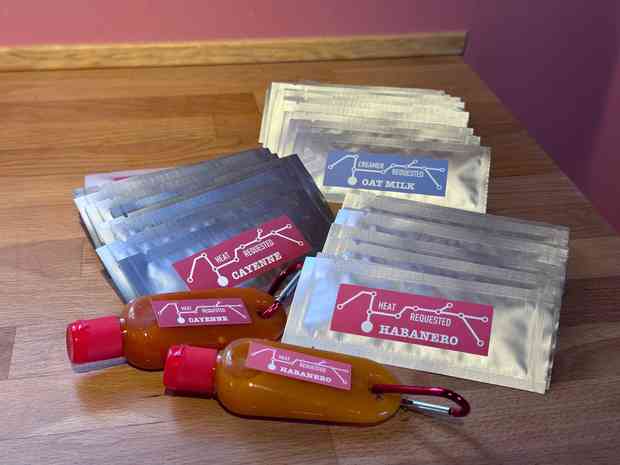This hotel room is trying real hard to not be a sad motel on the side of the highway in a San Francisco suburb.
Also, no I am not here for DreamForce, but that is why I am stuck at a hotel out here instead of the $2000/night downtown hotels.
Also, no I am not here for DreamForce, but that is why I am stuck at a hotel out here instead of the $2000/night downtown hotels.

My friend Catherine is publishing her first book of poetry on Monday, September 16! Barely a Whisper: Poems from the Heart of a Woman Re-becoming. Please check it out!
Has there been a tragic accident during eternal Caturday
Happy #8bitday — 256th day of the year! Here’s some reasons to celebrate:
bit = portmanteau of binary digit
8 binary digits can represent 256 different numerical values
8 bits are also a byte, the fundamental unit of computer storage — 'B' is for byte in 'GB' or 'TB' as an amount of memory (e.g. 24GB) or disk space (e.g. 2TB).
The '8' in UTF-8 also stands for 8 bits.
Beyond computer connections, there’s lots of 8-bit music and other forms of art.
Previously, previously, previously:
* https://tantek.com/2015/256/t2/happy-8bitday-this-year-konamicode
* https://tantek.com/2014/256/b1/happy-8-bit-day-8bitday
* https://tantek.com/2013/256/t1/happy-8-bit-day
* https://tantek.com/2012/256/t2/portland-xoxo-happy-8bitday
* https://tantek.com/2010/256/b1/happy-8-bit-day
* https://twitter.com/t/status/3960099908
Glossary
8-bit music
https://tantek.com/w/8bitday#Music
bit
https://en.wikipedia.org/wiki/Bit
byte
https://en.wikipedia.org/wiki/Byte
Gigabyte (GB)
https://en.wikipedia.org/wiki/Gigabyte
UTF-8
https://en.wikipedia.org/wiki/UTF-8
bit = portmanteau of binary digit
8 binary digits can represent 256 different numerical values
8 bits are also a byte, the fundamental unit of computer storage — 'B' is for byte in 'GB' or 'TB' as an amount of memory (e.g. 24GB) or disk space (e.g. 2TB).
The '8' in UTF-8 also stands for 8 bits.
Beyond computer connections, there’s lots of 8-bit music and other forms of art.
Previously, previously, previously:
* https://tantek.com/2015/256/t2/happy-8bitday-this-year-konamicode
* https://tantek.com/2014/256/b1/happy-8-bit-day-8bitday
* https://tantek.com/2013/256/t1/happy-8-bit-day
* https://tantek.com/2012/256/t2/portland-xoxo-happy-8bitday
* https://tantek.com/2010/256/b1/happy-8-bit-day
* https://twitter.com/t/status/3960099908
Glossary
8-bit music
https://tantek.com/w/8bitday#Music
bit
https://en.wikipedia.org/wiki/Bit
byte
https://en.wikipedia.org/wiki/Byte
Gigabyte (GB)
https://en.wikipedia.org/wiki/Gigabyte
UTF-8
https://en.wikipedia.org/wiki/UTF-8
I'm very pleased with tonight's project of packaging up hot sauce and oat milk in custom branded packets for Lily's upcoming "Stop Requested" trip!
It was a good chance to learn about mylar pouches and heat sealing.
It was a good chance to learn about mylar pouches and heat sealing.

Multnomah County Courthouse
Jury duty day 2

Hot sauce recipe live blog!
Step 1: Sautee chopped onion and garlic with some oil and salt in the instant pot until the onions are translucent
Step 1: Sautee chopped onion and garlic with some oil and salt in the instant pot until the onions are translucent

Came up with and tried a three phase pomodoro technique yesterday for working thru tasks and projects.
This three phase pomodoro cycle repeats and resyncs hourly. The three phases I came up with:
* physical tidying/cleaning
* physical processing
* digital processing
This worked quite well and I got a lot of things done, tasks completed or significantly advanced in ~6 hours.
Many of these were “annoying” or “boring” but often not immediately “necessary” tasks that I had left undone (procrastinated) for many weeks, especially with all the travel I have had in the past two months nevermind first two-thirds of this year.
I took the basic idea of a pomodoro 20-minute timebox¹, figured three of those fit into an hour, and picked three things that were cognitively different enough that switching from one to the other would use different cognitive skills (perhaps different parts of my brain), thus allowing a form of cognitive rest (rather than fatigue, and giving one part of my brain a chance to rest, while using others).
This eliminated the need to take “pomodoro breaks”, whether 5 minutes or 20-30 minutes and it felt nearly effortless (actually fun at times) to cycle through the three phases, repeatedly, for hours on end. Before I knew it six hours had gone by and many tasks had been completed.
The three 20 minute phases have the advantage of quickly determining at any time which phase you should be in by checking your watch/phone for :00-:20, :20-:40, :40-:00. If you happened to be “out of phase”, e.g. “run over” because you were finishing something up, rather than stressing about it, switch to the in-progress phase and pick-up a new task accordingly.
A 20 minute timebox also has the advantage that tasks are less annoying or boring when you know that in less than 20 minutes you will be able to set them down and switch to something else.
There was an iterative sense of expectation of novelty. The expectation of even only a little novelty was enough to make things go more quickly in the present, and even provide a game-like encouragement of see how far I can get with this boring or annoying task in the little time remaining. Could I even complete this one task in less than 20 minutes?
I think repeating three phase pomodoro cycles worked particularly well on a Saturday afternoon when I had very few external interrupts. I think that was key. It gave a sense of momentum, if actual flow², that itself felt like it gave me a source of energy to keep going. I’m not sure it would work during normal work hours in any highly or even partially collaborative environment.
Interruptions for physical needs, moving around, drinking, eating etc. were something that I allowed at any time, and that removed any stress about those too.
I rarely set any count-down timers. A few times when I recognized I was starting or picking up a task that I might get absolutely lost in (such as many digital processing tasks like email), I set an explicit count-down timer for the end of the phase. These timer alarms certainly helped to give me permission to put down that task (for now) and switch, rather than feeling compelled to “complete” it which I know from experience can often take much longer, and leave me feeling more tired, perhaps even too tired to do anything else.
There was also a sense of relief in knowing that even if I didn’t finish a particular task by the end of a phase, I would have the opportunity to pick it right back up in 40 minutes. Or maybe by then I would have decided to work on a different task in that phase.
This three phase pomodoro technique worked well for tasks that are not very cognitively engaging (hence boring or annoying). Such tasks have low context, and thus low context-switching costs, but still benefit from taking mental breaks and resets.
In contrast, any deeply cognitively engaging, thinking, or creative tasks, like inventing, coding, writing, typically have a much higher context-switching costs, and in my experience work better when you can set aside a longer block of time to allow yourself build up all the context and then joyfully explore the depths of whatever it is you’re creating.
That being said, I think some creative tasks (depending on the person) could benefit from time-boxing. Like having a constraint to write a short blog post in the morning before a workout or breakfast. Worth trying such one-off timeboxes or even formal pomodoros and seeing if they help complete some creative tasks faster (or more often) over time.
#productivity #pomodoro #pomodoroTechnique #gtd #gettingThingsDone #Saturday
References:
¹ Apparently I misremembered 20 minutes instead of the typical pomodoro 25 minutes: https://en.wikipedia.org/wiki/Pomodoro_Technique
² https://en.wikipedia.org/wiki/Flow_(psychology)
This three phase pomodoro cycle repeats and resyncs hourly. The three phases I came up with:
* physical tidying/cleaning
* physical processing
* digital processing
This worked quite well and I got a lot of things done, tasks completed or significantly advanced in ~6 hours.
Many of these were “annoying” or “boring” but often not immediately “necessary” tasks that I had left undone (procrastinated) for many weeks, especially with all the travel I have had in the past two months nevermind first two-thirds of this year.
I took the basic idea of a pomodoro 20-minute timebox¹, figured three of those fit into an hour, and picked three things that were cognitively different enough that switching from one to the other would use different cognitive skills (perhaps different parts of my brain), thus allowing a form of cognitive rest (rather than fatigue, and giving one part of my brain a chance to rest, while using others).
This eliminated the need to take “pomodoro breaks”, whether 5 minutes or 20-30 minutes and it felt nearly effortless (actually fun at times) to cycle through the three phases, repeatedly, for hours on end. Before I knew it six hours had gone by and many tasks had been completed.
The three 20 minute phases have the advantage of quickly determining at any time which phase you should be in by checking your watch/phone for :00-:20, :20-:40, :40-:00. If you happened to be “out of phase”, e.g. “run over” because you were finishing something up, rather than stressing about it, switch to the in-progress phase and pick-up a new task accordingly.
A 20 minute timebox also has the advantage that tasks are less annoying or boring when you know that in less than 20 minutes you will be able to set them down and switch to something else.
There was an iterative sense of expectation of novelty. The expectation of even only a little novelty was enough to make things go more quickly in the present, and even provide a game-like encouragement of see how far I can get with this boring or annoying task in the little time remaining. Could I even complete this one task in less than 20 minutes?
I think repeating three phase pomodoro cycles worked particularly well on a Saturday afternoon when I had very few external interrupts. I think that was key. It gave a sense of momentum, if actual flow², that itself felt like it gave me a source of energy to keep going. I’m not sure it would work during normal work hours in any highly or even partially collaborative environment.
Interruptions for physical needs, moving around, drinking, eating etc. were something that I allowed at any time, and that removed any stress about those too.
I rarely set any count-down timers. A few times when I recognized I was starting or picking up a task that I might get absolutely lost in (such as many digital processing tasks like email), I set an explicit count-down timer for the end of the phase. These timer alarms certainly helped to give me permission to put down that task (for now) and switch, rather than feeling compelled to “complete” it which I know from experience can often take much longer, and leave me feeling more tired, perhaps even too tired to do anything else.
There was also a sense of relief in knowing that even if I didn’t finish a particular task by the end of a phase, I would have the opportunity to pick it right back up in 40 minutes. Or maybe by then I would have decided to work on a different task in that phase.
This three phase pomodoro technique worked well for tasks that are not very cognitively engaging (hence boring or annoying). Such tasks have low context, and thus low context-switching costs, but still benefit from taking mental breaks and resets.
In contrast, any deeply cognitively engaging, thinking, or creative tasks, like inventing, coding, writing, typically have a much higher context-switching costs, and in my experience work better when you can set aside a longer block of time to allow yourself build up all the context and then joyfully explore the depths of whatever it is you’re creating.
That being said, I think some creative tasks (depending on the person) could benefit from time-boxing. Like having a constraint to write a short blog post in the morning before a workout or breakfast. Worth trying such one-off timeboxes or even formal pomodoros and seeing if they help complete some creative tasks faster (or more often) over time.
#productivity #pomodoro #pomodoroTechnique #gtd #gettingThingsDone #Saturday
References:
¹ Apparently I misremembered 20 minutes instead of the typical pomodoro 25 minutes: https://en.wikipedia.org/wiki/Pomodoro_Technique
² https://en.wikipedia.org/wiki/Flow_(psychology)













